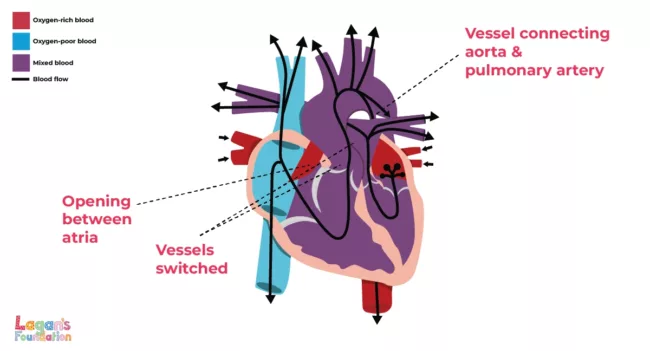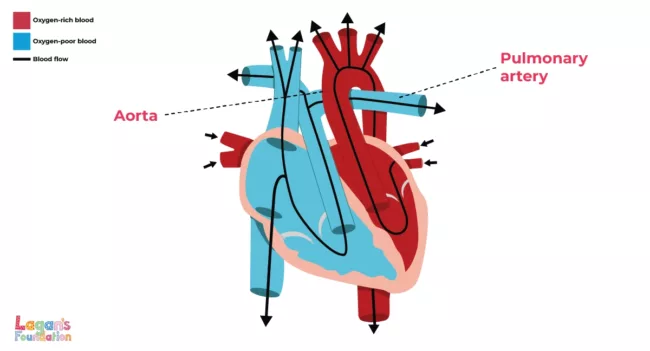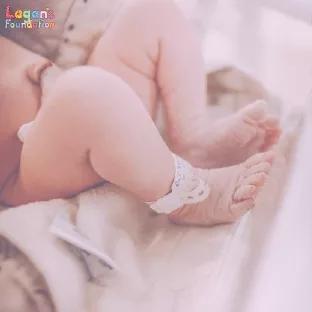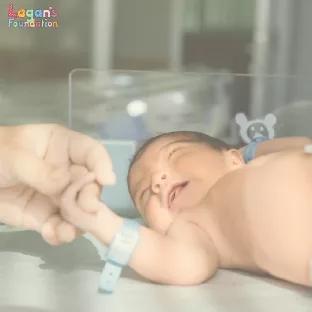A Simple Guide to Transposition of the Great Arteries
Different types of Transposition of the Great Arteries
Transposition of the Great Arteries is a congenital heart defect that occurs when the two main blood vessels in the heart are in abnormal positions.
In this guide, we’ll discuss the different types of Transposition of the Great Arteries, how it affects the body, the signs and symptoms and what treatment options are available.
Key Points:
- Symptoms of Transposition of the Great Arteries will usually appear very quickly after birth, usually in the first few hours or days.
- There are two types of Transposition of the Great Arteries: Dextro transposition of the great arteries and Levo transposition of the great arteries.
- Surgical repair is usually required within the first few weeks of life.
What is Transposition of the Great Arteries in Children?
Transposition of the Great Arteries (TGA) in children is a serious congenital heart defect that occurs when the two main arteries leaving the heart are switched in position.
TGA is a rare life threatening condition and babies who are born with it will need surgery soon after birth.

The difference between a normal heart and TGA heart
In a normal heart, the pulmonary artery is connected to the right ventricle and the aorta is connected to the left ventricle. In Transposition of the Great Arteries, the aorta and pulmonary artery are switched in position.
As a result of the positions being switched:
- The aorta is connected to the right ventricle instead of the left
- The pulmonary artery is connected to the left ventricle instead of the right
Types of Transposition of the Great Arteries
There are two different types of Transposition of the Great Arteries:

- Dextro transposition of the great arteries (D-TGA) – D-TGA is the most common form of TGA and it occurs when the aorta is positioned to the right of the pulmonary artery. This type of TGA almost always needs to be repaired during the first year of a baby’s life.
- Levo transposition of the great arteries (L-TGA) – L-TGA is also known as Congenitally Corrected Transposition of the Great Arteries, and it occurs when the aorta is positioned to the left of the pulmonary artery. If the TGA occurs without other heart defects, it may not require surgery in early life.
What causes Transposition of the Great Arteries?
While the cause of Transposition of the Great Arteries is not fully known, many experts believe it is related to abnormalities in certain genes and chromosomes.
It is also believed that certain factors can increase the chances of TGA, such as:
- A family history of congenital heart defects
- Pregnancy related issues, such as smoking, drinking alcohol, uncontrolled diabetes and taking certain medication.
Signs and symptoms of Transposition of the Great Arteries in children
The symptoms of Transposition of the Great Arteries will typically appear in the first few hours or days after birth, and they will usually exhibit signs such as:
- Fast or laboured breathing
- Low appetite
- Poor feeding
- Rapid heart rate
- Weak pulse
- Bluish skin, lips and nails
Some babies may also show poor weight gain, however, most symptoms will usually appear quite quickly after birth.
How is Transposition of the Great Arteries diagnosed?
Sometimes Transposition of the Great Arteries will be diagnosed before birth through a prenatal ultrasound, which is an imaging examination that is conducted while the baby is still in the womb.
If the TGA is not detected in the womb and the baby is showing symptoms after birth, a doctor may conduct an echocardiogram to get an image of the heart structure.
Other tests that might be used include:
- X-rays – A quick, painless procedure that uses radiation to create images of the inside of the body.
- Electrocardiograms – A test that is used to measure the electrical activity of the heart.
- Pulse oximetry – A painless test that measures the amount of oxygen in the blood and how far the oxygen-rich blood is being sent around the body.
Treatment options for Transposition of the Great Arteries
Babies who are born with Transposition of the Great Arteries will usually need to have surgery in the first few weeks of life to repair the defect. Without the correct treatment, most babies will not survive the first year of life.
Surgery to treat Transposition of the Great Arteries:
- Arterial switch operation – This is the most common type of surgery for TGA and it involves cutting and reattaching the aorta and pulmonary artery to the correct ventricles. Other heart defects will also be fixed during this surgery.
- Arterial septostomy – This is a procedure (sometimes used as a temporary fix before further surgery) where a little hole is made in the wall between the left and right atria of the heart. It’s often done with a cardiac catheter, and the aim is to widen the connection between the heart’s upper chambers, helping to mix oxygen-rich and oxygen-poor blood to improve oxygen levels in the body.
- Rastelli procedure – This surgery may be conducted if the baby has TGA and a Ventricular Septal Defect, which is a hole in the heart. The surgeon will patch the hole and redirect blood flow from the left lower heart chamber to the aorta. An artificial valve is also used to connect the right lower heart chamber to the lungs.
- Double switch procedure – This surgery is used to correct L-TGA, or congenitally corrected transposition. It redirects blood flow coming into the heart and switches the great artery connection so the lower left chamber pumps oxygen-rich blood into the aorta.
After surgery, many babies will require life long care and will likely need some form of medical management, such as pacemakers or medicine.
What is the life expectancy of a child with Transposition of the Great Arteries?
The life expectancy of a child with Transposition of the Great Arteries is high after the correct surgery, however, many babies will not survive the first year of life if they do not receive surgery.
Most children will go on to live healthy, unrestricted lives with the correct surgery with early diagnosis being crucial for optimal outcomes. Most babies will be required to stay in hospital for up to two weeks after surgery and are unlikely to need any other additional surgery.
Living with Transposition of the Great Arteries
While most children who receive corrective surgery for Transposition of the Great Arteries will live healthy lives, some children might have complications such as:
- Heart muscle problems
- Heart valve leakage
- Pulmonary artery narrowing
- Enlargement of the aorta
Long-term follow up care with a cardiologist is usually necessary throughout childhood and sometimes even into adulthood depending on what type of surgery that was performed after birth.

![Understanding Total Anomalous Pulmonary Venous Return [TAPVR]](/wp-content/uploads/2025/04/Understanding-Total-Anomalous-Pulmonary-Venous-Return-FI-312x312-c-default.jpg)


